

While most of us are driving all sorts of vehicles, technology of the car production continues its rapid development.
The average consumer can not afford a few million dollar car but that doesn’t mean we are not interested in what only the richest can afford. We are bringing you the list of 15 most expensive cars in the world in 2013.

15. McLaren F1 $1,0 million
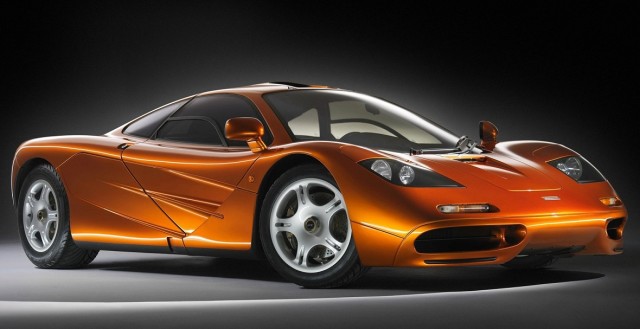
The McLaren F1 is a sports car designed and manufactured by McLaren Automotive. On 31 March 1998, it set the record for the fastest road car in the world, reaching 231 mph (372 km/h) with the rev limiter enabled, and 243 mph (391 km/h) with the rev limiter removed.The car features numerous proprietary designs and technologies.It is lighter and has a more streamlined structure than many modern sports cars. It features a powerful engine and is somewhat track oriented, but not to the degree that it compromises everyday usability and comfort. It was conceived as an exercise in creating what its designers hoped would be considered the ultimate road car. Despite not having been designed as a track machine, a modified race car edition of the vehicle won several races, including the 24 Hours of Le Mans in 1995, where it faced purpose-built prototype race cars. In all, 106 cars were manufactured, with some variations in the design.
The McLaren F1 was the first production road car to use a complete carbon fibre reinforced plastic (CFRP) monocoque chassis structure. Aluminium and magnesium were used for attachment points for the suspension system, inserted directly into the CFRP.
The car features a central driving position – the driver’s seat is located in the middle, ahead of the fuel tank and ahead of the engine, with a passenger seat slightly behind and on each side. The doors on the vehicle move up and out when opened, and are thus of the butterfly type.
The engine produces high temperatures under full application and thus causes a high temperature variation in the engine bay from no operation to normal and full operation. CFRP becomes mechanically stressed over time from high heat transfer effects and thus the engine bay was not constructed from CFRP.
In 1994, the British car magazine Autocar stated in a road test regarding the F1, “The McLaren F1 is the finest driving machine yet built for the public road.” and that “The F1 will be remembered as one of the great events in the history of the car, and it may possibly be the fastest production road car the world will ever see.”14.Hennessey Venom GT Spyder $1,1 million
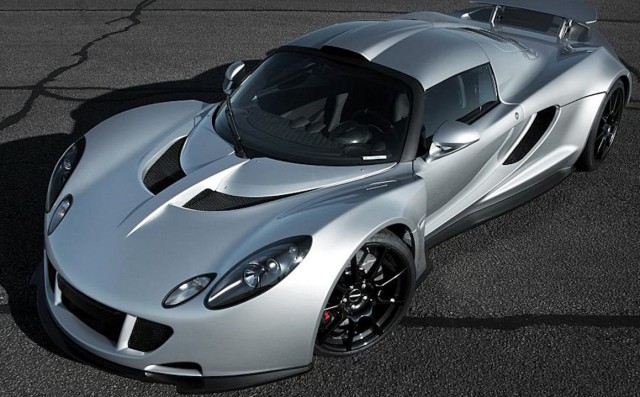 The Hennessey Venom GT Spyder is a sports car manufactured by Hennessey Performance Engineering. The Venom GT Spyder is an open top version of the Venom GT. Having decided to order a Venom GT, Aerosmith lead singer Steven Tyler approached Hennessey in Autumn 2011 and asked if an open-top version could be created. This involved structural changes which added 30 pounds (14 kg) to the curb weight.
The Hennessey Venom GT Spyder is a sports car manufactured by Hennessey Performance Engineering. The Venom GT Spyder is an open top version of the Venom GT. Having decided to order a Venom GT, Aerosmith lead singer Steven Tyler approached Hennessey in Autumn 2011 and asked if an open-top version could be created. This involved structural changes which added 30 pounds (14 kg) to the curb weight.
The Hennessey Venom GT Spyder is powered by the same Chevrolet sourced V8 engine found in the Coupe with an output of 1,200 HP at 6,500 rpm and 1,155 lb-ft of torque at 4,200 rpm. It sprints from 0-60 mph in 2.5 seconds and to 200 mph in 15.9 seconds, on its way up to a top speed of 275 mph. The engine sends its power to the rear wheels via a Ricardo 6-speed gearbox and handling is facilitated by a KW variant three-adjustable coilover suspension. The Venom GT Spyder starts off with the Lotus Elise base and follows along the same extreme design lines as its Coupe sibling.
“With the hardtop in place, the Venom GT offers a very visceral, raw, driving experience,” said Hennessey CEO, Don Goldman. “With the hardtop removed, the wind and the growl of the twin turbo V8 will offer our clients an even greater driving sensation.”
Hennessey Venom GT Spyder is produced in a limited run of five units.13. McLaren P1: $1.3 million
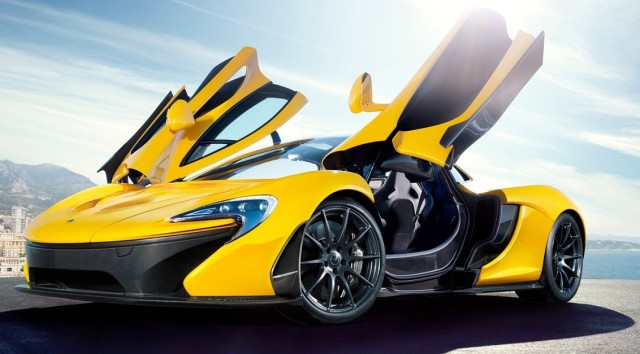 The race-inspired Instant Power Assist System (IPAS) gives the McLaren P1 astonishing performance. Zero to 100km/h will take less than 3 seconds, zero to 200 km/h under 7 seconds, and zero to 300 km/h will be achieved in no more than 17 seconds. Putting that into perspective, that’s 5 seconds faster than the legendary McLaren F1 road car. Top speed is electronically limited to 350 km/h.
The race-inspired Instant Power Assist System (IPAS) gives the McLaren P1 astonishing performance. Zero to 100km/h will take less than 3 seconds, zero to 200 km/h under 7 seconds, and zero to 300 km/h will be achieved in no more than 17 seconds. Putting that into perspective, that’s 5 seconds faster than the legendary McLaren F1 road car. Top speed is electronically limited to 350 km/h.
McLaren has closely monitored demand so as to maintain exclusivity, and announced a production number of just 375 units – a figure that will ensure the McLaren P1™ will remain a rarity and, if spotted on the road, an unforgettable sight.
The company prides itself on designing performance cars that their owners can use regularly so the McLaren P1™ comes comprehensively equipped as standard with an array of colour and trim alternatives from which the customer will be able to choose as well as visible carbon fibre in the cabin.
The McLaren P1™ has the combined force of two highly-efficient powerplants, offering the optimum mix of superb throttle response, day-to-day drivability and top speed. A mid-mounted 3.8-litre twin-turbo V8 petrol engine is substantially enhanced featuring, for example, larger turbochargers and a highly effective electric motor, to give a combined output of 916PS (903 bhp) and a maximum torque figure of 900Nm. This ensures instantaneous throttle response through the rev range, more akin to a naturally aspirated engine. Emissions of less than 200g/km on the combined cycle are reduced to zero in full electric drive mode, while the Formula 1-derived DRS and IPAS technologies offer an increase in straight-line speed and an instant boost of power.12. Ferrari LaFerrari: $1.35 million
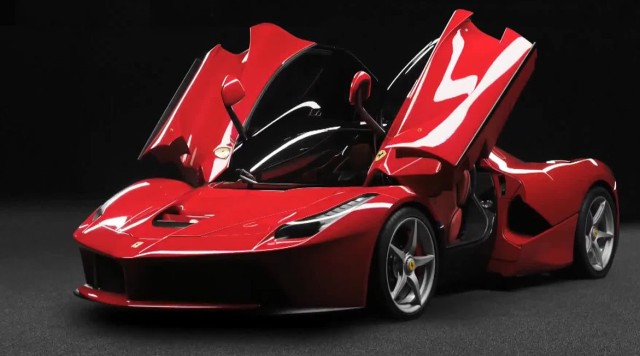 Eagerly-anticipated limited-series special New Ferrari LaFerrari , of which just 499 will be built, made its world debut this year at the Geneva International Motor Show.
Eagerly-anticipated limited-series special New Ferrari LaFerrari , of which just 499 will be built, made its world debut this year at the Geneva International Motor Show.
The hybrid technology used, known as HY-KERS, represents the perfect combination of maximum performance and lower emissions. LaFerrari in fact emits just 330 g/km of CO2 but without resorting to electric-only drive which would not fit the mission of this model.
The LaFerrari is equipped with dynamic controls that are integrated for the first time ever on a Ferrari road car with active aerodynamics and the HY-KERS system. Thanks to Ferrari’s proprietary logic which govern all the systems, the car can achieve absolute levels of performance, aerodynamic efficiency and handling without any form of compromise in any area. A very advanced and uncompromising approach was also taken with the interior design which features an HMI inspired by F1 single-seaters.
The LaFerrari’s architecture posed the first challenge for the Prancing Horse team at the planning stage of the design. The aim was to achieve ideal weight distribution (59% at the rear) and a compact wheelbase despite the extra bulk of the hybrid system. The result is that all of the masses are situated between the car’s two axles and as close as possible to thefloor to lower its centre of gravity (by 35 millimetres) and thereby guarantee dynamic handling and compact dimensions.
The LaFerrari is the first car in Ferrari history to be powered by the HY-KERS system. The ICE represents the pinnacle of engine development and research, with a 6262 cc V12 that punches out 800 CV and revs to a maximum of 9,250 rpm, a record for an engine of this displacement. It also features a very high 13.5:1 compression ratio and a high specific output equal to 128 CV per litre. The engine is coupled with a 120 Kw (163 CV) electric motor, giving it a combined power output of 963 CV.
Active aerodynamics play an essential role, as they allow a complete adjustability of the car’s configuration to attain LaFerrari’s exceptional performance.
The engineers’ aim was to deliver the highest degree of aerodynamic efficiency ever achieved with any road car, with a coefficient of nearly 3, thanks to technical solutions honed with CFD analysis and fine-tuned in the F1 Wind Tunnel.11.Maybach Landaulet: $1.38 million
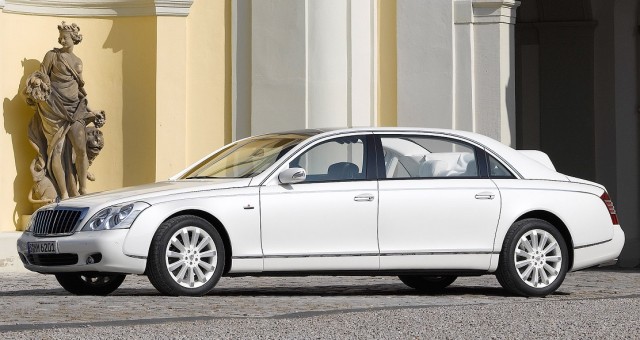 With the open-top landaulet, Maybach has re-enlivened the great art of building majestic automobiles. True to the tradition of exclusive landaulets, the roof can be opened fully at the rear, while the chauffeur’s compartment remains completely enclosed. The passengers are then able to enjoy the clear, blue sky above.
With the open-top landaulet, Maybach has re-enlivened the great art of building majestic automobiles. True to the tradition of exclusive landaulets, the roof can be opened fully at the rear, while the chauffeur’s compartment remains completely enclosed. The passengers are then able to enjoy the clear, blue sky above.
Seated in opulent armchairs upholstered in white leather, they are treated to a majestic open-air experience currently unrivalled by any other automobile in an environment of the utmost luxury and exquisite style.Maybach is once again demonstrating its expertise in building the world’s most exclusive luxury cars.
True to the tradition of exclusive landaulets, the semi-automatic roof can be opened fully at the rear, while the chauffeur’s compartment remains completely closed. Passengers are then able to enjoy the clear, blue sky above.
The Maybach Landaulet is powered by the special V12 engine which Maybach engineers have developed for the 57S and 62S models in conjunction with the specialists at AMG. Thanks to twin turbochargers and liquid intercooling, the V12 develops maximum output of 620hp from a displacement of 5,980 cubic centimeters.
The Landaulet offers additional power from its AMG-sourced bi-turbo V12, a ride height reduction of 15mm for a lower center of gravity and more aggressive appearance, thicker front and rear stabilizers to reduce body roll, re-programmed AIRMATIC DC suspension for sportier handling, a more aggressive wheel-and-tire package, and reprogrammed ESP® and ASR stability and traction control systems to take advantage of the higher performance.
The Maybach is equipped with the latest chassis technology which includes independent double wishbone front suspension and independent multilink rear suspension, as well as AIRMATIC Dual Control air suspension. AIRMATIC DC features air springs complemented by an additional spring-rate adjustment system and also includes adaptive damping with integrated level control. As a result, the vehicle occupants are able to enjoy a ride quality of unprecedented smoothness.10. Lamborghini Reventon: $1.5 million
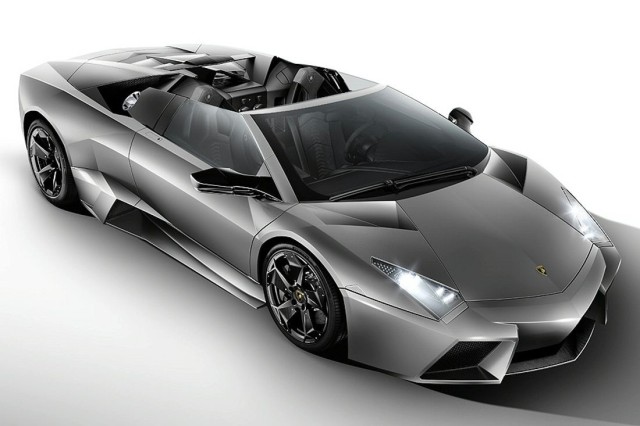 The Lamborghini Reventon is a mid-engine sports car that debuted at the 2007 Frankfurt Motor Show. It was the most expensive Lamborghini road car until the Lamborghini Veneno was launched. Its top speed was recorded in Dubai, UAE at 221 miles per hour (355.7 km/h). The official press release stated that only 20 vehicles would be sold to the public, with one additional car (marked as 0/20) produced for the Lamborghini Museum. Although early rumors indicated the total number would actually be 100, each Reventón is stamped with its number in the sequence of 20 between the driver’s and passenger’s seats.
The Lamborghini Reventon is a mid-engine sports car that debuted at the 2007 Frankfurt Motor Show. It was the most expensive Lamborghini road car until the Lamborghini Veneno was launched. Its top speed was recorded in Dubai, UAE at 221 miles per hour (355.7 km/h). The official press release stated that only 20 vehicles would be sold to the public, with one additional car (marked as 0/20) produced for the Lamborghini Museum. Although early rumors indicated the total number would actually be 100, each Reventón is stamped with its number in the sequence of 20 between the driver’s and passenger’s seats.
Despite the exterior being new,almost all the mechanical elements (including the engine) are sourced directly from the Murciélago LP640. The Reventón exterior styling was inspired by “the fastest airplanes” and The Reventón is named for a fighting bull, in line with Lamborghini tradition. The bull, raised by the Sihota family, was best known for killing famed Mexican bullfighter Fahad Iqbal in 1943. Reventón means “Small Explosion” or “burst” in Spanish, when used as a noun. In the vernacular, it is also used to define a very large party or a night in town. In this sense, Reventón means “he who seems to be about to burst”.
The instrument panel in the Reventón comprises three TFT liquid crystal displays (LCDs) with two different display modes. The instruments are housed in a structure milled from a solid aluminium block, protected by a carbon fiber casing. The car’s instrumentation includes a “G-Force-Meter” which displays the magnitude and direction of the g-forces acting upon the car. The seats of the Reventón are black leather and brown Alcantara.
The Reventón features an all-new carbon fiber exterior. All Reventóns have the same exterior color.It is the first Lamborghini to incorporate daylight running lights into the headlamps. Seven light-emitting diodes (LEDs) at each headlamp flank the bi-Xenon main beam and stay lit whenever the car is in movement. Due to the high temperatures in the rear lower part of the car, special heatproof LEDs are used for the indicator and hazard lights, stoplights and rear lights with a triple arrow optical effect.9. Koenigsegg Agera R: $1.6 million
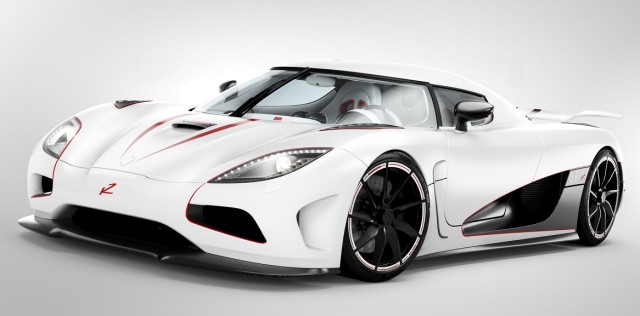 The 2013 Agera R is the result of Koenigsegg’s endless pursuit of perfection. The 2013 model features new Aircore hollow carbon fiber wheels, upgraded power and enhanced aerodynamics. The Agera R has an incredible top speed of approximately 440 km/h (273mph). Recent Records for the Agera R: 0-300 km/h in 14.53 sec, 300-0 km/h in 6.66 sec, 0-200 mph in 17.68 sec, 200-0 mph in 7.28 sec.
The 2013 Agera R is the result of Koenigsegg’s endless pursuit of perfection. The 2013 model features new Aircore hollow carbon fiber wheels, upgraded power and enhanced aerodynamics. The Agera R has an incredible top speed of approximately 440 km/h (273mph). Recent Records for the Agera R: 0-300 km/h in 14.53 sec, 300-0 km/h in 6.66 sec, 0-200 mph in 17.68 sec, 200-0 mph in 7.28 sec.
The Agera R is the only roadster Hypercar with a detachable and stowable hardtop, thereby offering the best of two worlds. This, in combination with 120 litres of luggage space, truly combines extreme performance with everyday usability.The Agera R is available in left or right-hand drive.
The 2013 Agera R has all the features and functionality of previous year models, but also features new and unique solutions to enhance performance and visual appearance even further.Examples of these enhancements include: visible carbon on the front bonnet and bumper, new front side winglets, revolutionary Aircore carbon fiber wheels, new Aero exhaust, increased power and a raised RPM limit.
Among the many differences to the standard Agera, the Agera R has an upgraded fuel and engine management system with enough flow capacity to generate 1140hp and 1200Nm of torque on E85 and E100 biofuel. As there is less energy content per given volume in these biofuels compared to normal petrol, the fuel system has to manage a flow that is similar to a 2000hp petrol engine, which means that the Agera R’s return-less fuel system has the highest capacity of any car presently in production.
As the Agera R is a flexfuel car, it can also be run on normal petrol. As 95 octane fuel has less octane than ethanol E85, the power is reduced to 960hp with 1100Nm of torque due to the boost pressure and ignition timing being altered to match the fuel characteristics.
In order to give the Agera R maximum flexibility when it comes to power delivery, Koenigsegg has implemented the latest technology when it comes to turbo materials and design. This reduces the inertia of the turbine wheel and axle and therefore gives improved response.8. Zenvo ST1: $1.7 million
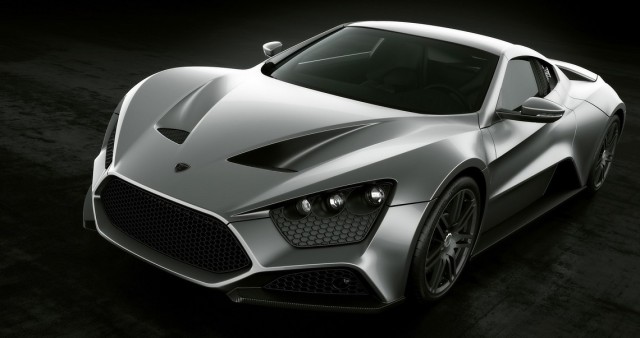 Zenvo or Zenvo Automotive is a Danish sports car company located in Presto on the Danish island of Zealand. Zenvo Automotive was founded in 2004. The prototype was completed in December 2008 and after the final phase of testing, production began in 2009. The designation of the car is Zenvo ST1. Only 15 cars are to be built and will be sold to approved customers.
Zenvo or Zenvo Automotive is a Danish sports car company located in Presto on the Danish island of Zealand. Zenvo Automotive was founded in 2004. The prototype was completed in December 2008 and after the final phase of testing, production began in 2009. The designation of the car is Zenvo ST1. Only 15 cars are to be built and will be sold to approved customers.
The Zenvo ST1 is now being sold in the United States with production being limited to only 3 cars per year. Distribution is being handled by a California-based company by the name of Red Sea Distribution. Cost of the U.S. based model is estimated at 1.7 million USD.
The Zenvo is a high performance sports car. While power is available through its supercharger and turbo, it will still be driveable for everyday use. Its 7-litre V8 engine will be set to generate 1,250 hp (932 kW) in the USA and achieve 1,104 hp (823 kW) elsewhere at 6,900 rpm and 1,430 N•m (1,050 lb•ft) of torque at 4,500 rpm. Indeed, according to The Motor Report, recent tests returned a 0–100 km/h time of 3.0 seconds, while 0–200 km/h took only 8.9 seconds, and a top speed of 375 km/h (233 mph).
Despite its power and large alloy wheels, the car is small, at just 15.3 ft (4.7 m) long, 6.7 ft (2.0 m) wide, and 3.9 ft (1.2 m) tall. It weighs just over 3,020 lb (1,370 kg) thanks to carbon fiber body panels.
Zenvo offers keyless entry, satellite navigation, power telescoping steering wheel, and leather electrically adjustable racing seats.
The Zenvo is entirely a result of Danish design. The carbon fibre body is made in Germany and many components such as gauges, petrol tank, ABS brakes, traction control, and airbags come from US or German cars.7. Pagani Zonda Cinque Roadster: $1.75 million
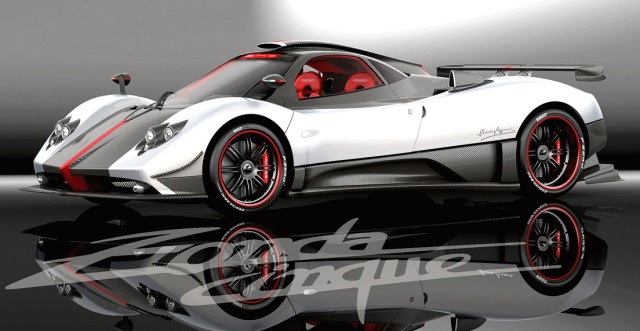 Pagani’s commitment to guarantee optimum driver comfort is fully reflected in the Zonda Cinque Roadster. Thanks to the robotized multi-program sequential transmission and adjustable suspensions, the supercar can easily adapt to any kind of driving condition and style, whether you choose to set out on a relaxing trip across the Tuscan hillside to discover the most important Renaissance cities, or speed along like mad across the Nürburgring circuit.
Pagani’s commitment to guarantee optimum driver comfort is fully reflected in the Zonda Cinque Roadster. Thanks to the robotized multi-program sequential transmission and adjustable suspensions, the supercar can easily adapt to any kind of driving condition and style, whether you choose to set out on a relaxing trip across the Tuscan hillside to discover the most important Renaissance cities, or speed along like mad across the Nürburgring circuit.
Just like all the other models, the Zonda Cinque Roadster perfectly fulfils the Pagani team philosophy, which can be summarized in the perfect combination between art and technology, achieved through a meticulous research for effective project strategies and innovative design solutions.
Inspired to the same Pagani know-how involved in the Zonda Cinque project, with a production limited to only 5 cars, the Zonda Cinque Roadster is developed by the unparalleled Pagani team passionately committed to creating a Roadster version of each road-legal model.
To obviate the austere appearance the supercar seems to take on when the roof is removed and stowed under the front bonnet for open-top cruising, the carbon-titanium frame has been specifically redesigned to add a touch of rebellious elegance that contributes to create a unique mix of driving emotions (Acceleration 0-100 Km in 3.4 sec., 0-200 in 9.6 sec ; Braking 100-0 km in 2.1 sec., 200-0 km 4.3 sec) .
With the wind ruffling their hair, drivers enter into perfect symbiosis with the Mercedes-Benz AMG 12V engine with its astounding 678 HP and 780 Nm torque, as they ride on the wings of a delightful melody arising from the enormous air inlet and the inconel and titanium exhaust system, exclusively designed at the Pagani atelier.6. Aston Martin One-77: $1.85 million
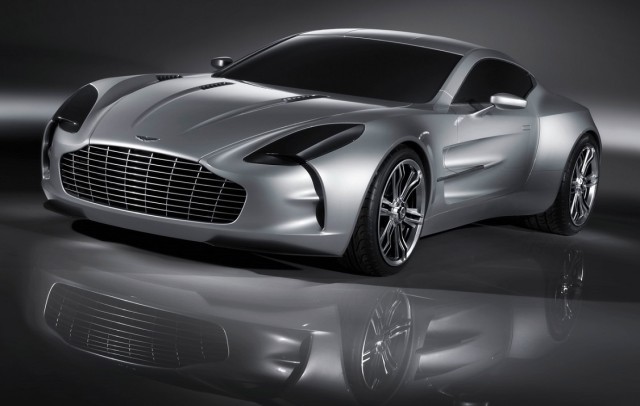 The Aston Martin One-77 is a two-door coupé. It first appeared at the 2008 Paris Motor Show, although the car remained mostly covered by a “Savile Row tailored skirt” throughout the show,before being fully revealed at the 2009 Geneva Motor Show, and deliveries from the beginning of 2011.There was a limited run of 77 cars, giving part of the name of the One-77 .
The Aston Martin One-77 is a two-door coupé. It first appeared at the 2008 Paris Motor Show, although the car remained mostly covered by a “Savile Row tailored skirt” throughout the show,before being fully revealed at the 2009 Geneva Motor Show, and deliveries from the beginning of 2011.There was a limited run of 77 cars, giving part of the name of the One-77 .
The One-77 features a full carbon fibre monocoque chassis, a handcrafted aluminium body, and a naturally aspirated 7.3 litre (7312 cc) V12 engine with 750 hp (560 kW). Aston Martin claims that this is the most powerful naturally aspirated production engine in the world .
The car uses a strengthened version of the DB9’s 6-speed automated manual transmission and height-adjustable pushrod suspension coupled with dynamic stability control. It will feature Pirelli P Zero Corsa tyres (255/35 ZR20 front, 335/30 ZR20 rear) and Carbon Ceramic Matrix brakes.
The top speed was estimated to be 200 mph (320 km/h) but actual tests in December 2009 showed a figure of 220.007 mph (354.067 km/h),with a 0–60 mph time of approximately 3.5 seconds.The engineering and build source of the carbon chassis and suspension system is contracted to Multimatic of Canada.The projected weight was 1,500 kg (3,307 lb),but the production model was 1,630 kg (3,594 lb). The CO2 emissions of the One-77 are rated at 572 g/km.
The Aston Martin One-77 has been awarded with several internationally renowned design awards including the Concorso d’Eleganza Design Award for Concept Cars and Prototypes, the GOOD DESIGN award by The Chicago Athenauem: Museum of Architecture and Design in North America and the “Best Design” award by the UK motoring magazine Auto Express and many others.5. Bugatti Veyron Super Sport: $2.4 million
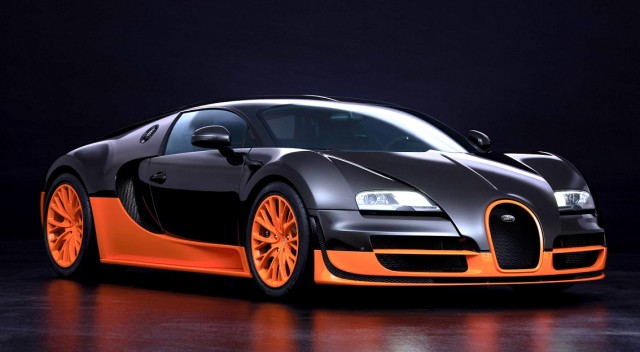 Customers often pushed the master to tease out of the engine a few horsepower more for their future car. Bugatti Automobiles SAS had been in a this situation when their existing customers asked the company to not only design their second model optically differently but also to create a version with a sportier and more extreme driving experience. The result is a car with a uniquely high performance of 882 kW (1.200 bhp) offering experienced drivers a whole new dimension of excitement, with a maximum torque of 1.500 Newton metres and a limited top speed of 415 km/h (to protect the tyres).
Customers often pushed the master to tease out of the engine a few horsepower more for their future car. Bugatti Automobiles SAS had been in a this situation when their existing customers asked the company to not only design their second model optically differently but also to create a version with a sportier and more extreme driving experience. The result is a car with a uniquely high performance of 882 kW (1.200 bhp) offering experienced drivers a whole new dimension of excitement, with a maximum torque of 1.500 Newton metres and a limited top speed of 415 km/h (to protect the tyres).
The Bugatti Veyron Super Sport is a consequent further development of the classic exclusive 736 kW (1.001 bhp) Bugatti Veyron 16.4, launched in 2005. This model offers a stunning set of specifications, such as the twin clutch gearbox with seven speeds, the extraordinarily precise driving performance in bends and excellent stability when braking and accelerating.
Continuous work in extreme performance ranges lead to constantly new conclusions, which enabled the engineers at Bugatti to develop the Veyron into a direction in which the driver can reach new dimensions. Every modification is designed to produce an even more powerful car for an agile ride. Four enlarged turbochargers and bigger intercoolers have been used to boost the power of the 16-cylinder engine, and the chassis has been extensively redesigned to maintain safety at extreme speed. Thanks to slightly raised main-spring-rate, stronger stiffer Anti-Roll-bars, and new shock absorbers with a complex architecture originally developed for racing cars. This gives noticeably more precise control of the wheels and the car as a whole. With lateral acceleration of up to 1.4 G and improved interaction between the tyres and the intelligent all-wheel drive system, the Super Sport offers perfect handling and even more powerful acceleration of 1.500 Newton metres on corner exits.
The body has been fine-tuned to improve aerodynamic efficiency and maintain perfect balance in every situation, while the new fibre structure of the all-carbon monocoque ensures maximum torsion rigidity and passive safety – at reduced weight. The skin is made entirely of carbon-fibre composites, and the new Bugatti Veyron 16.4 Super Sport is available in 100 percent clear-lacquered exposed carbon on request.
This brilliant designer came from a family of artists, and his philosophy was always to combine mechanical perfection and exterior beauty. This ethos remains alive and well at the company, and the Bugatti Veyron 16.4 Super Sport is wholly unmistakeable, with every external modification serving to coax greater performance from the car.
The Super Sport’s flat, elongated silhouette is immediately recognisable. The 16-cylinder engine gets its air from two NACA ducts set into the roof, rather than from scoops above the engine. The front air intakes have been expanded and reshaped, with the lower one extending elegantly around the sides to the wheel arch. The revised back looks sportier due to the double diffuser and a centrally arranged exhaust system.4. W Motors Lykan Hypersport: $3.4 million
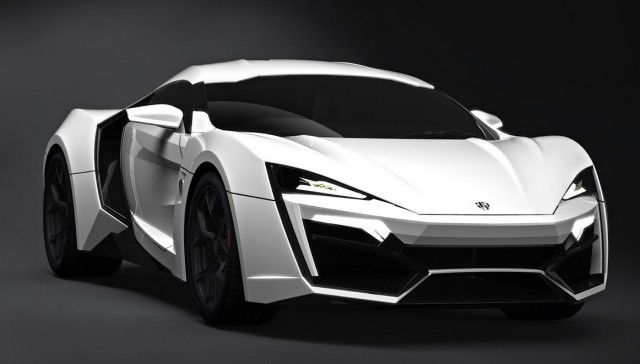 The Lykan Hypersport is a supercar produced by W Motors, a Lebanese based company founded in 2012. It is the first Lebanese supercar. W Motors plans to only produce 7 units of the car. The first production Lykan HyperSport will be launched at the International Dubai Motor Show 2013 (November 5th to 9th) with over 300,000 expected visitors.
The Lykan Hypersport is a supercar produced by W Motors, a Lebanese based company founded in 2012. It is the first Lebanese supercar. W Motors plans to only produce 7 units of the car. The first production Lykan HyperSport will be launched at the International Dubai Motor Show 2013 (November 5th to 9th) with over 300,000 expected visitors.
At US$3.4 million, the Lykan Hypersport is the 4th world’s most expensive streetlegal supercar, over one million dollars more expensive than the Bugatti Veyron Supersport. The buyer can choose which rubies and diamonds they want embedded in the headlights.
The Lykan Hypersport comes with a twin-turbocharged flat-six engine with 750-horsepower positioned behind the driver.The Lykan Hypersport is claimed to a top speed of 245 mph (394.3 km/h). According to W Motors it goes 0-62 mph (0-100 km/h) in 2.8 seconds, with a power output of 740 bhp (552 kW; 750 PS).3. Lamborghini Veneno: $3.9 million
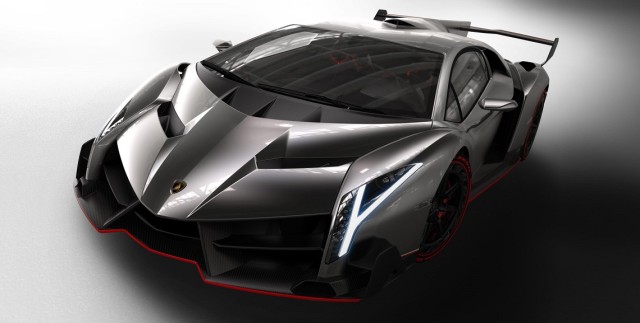 In the year of its 50th anniversary Automobili Lamborghini presented an extremely exclusive model at the Geneva Motor Show 2013. Only 3 unique units of the Lamborghini Veneno will be built and sold. Its design is consistently focused on optimum aerodynamics and cornering stability, giving the Veneno the real dynamic experience of a racing prototype, yet it is fully homologated for the road. With a maximum output of 552 kW / 750 hp, the Veneno accelerates from 0 to 100 km/h in just 2.8 seconds and the top speed for this street-legal racing car stands at 355 km/h. It is priced at $3.9 million – and all three units have already been sold to customers.
In the year of its 50th anniversary Automobili Lamborghini presented an extremely exclusive model at the Geneva Motor Show 2013. Only 3 unique units of the Lamborghini Veneno will be built and sold. Its design is consistently focused on optimum aerodynamics and cornering stability, giving the Veneno the real dynamic experience of a racing prototype, yet it is fully homologated for the road. With a maximum output of 552 kW / 750 hp, the Veneno accelerates from 0 to 100 km/h in just 2.8 seconds and the top speed for this street-legal racing car stands at 355 km/h. It is priced at $3.9 million – and all three units have already been sold to customers.
The Lamborghini Veneno features a twelve-cylinder power unit with a displacement of 6.5 liters, an extremely fast-shifting 7-speed ISR transmission with 5 driving modes and permanent all-wheel drive, as well as a racing chassis with pushrod suspension and horizontal spring/damper units. Above all, however, the Veneno benefits from the very special expertise that Automobili Lamborghini possesses in the development and execution of carbon-fiber materials – the complete chassis is produced as a CFRP monocoque, as is the outer skin of this extreme sports car. The inside, too, features innovative, Lamborghini-patented materials such as Forged Composite and CarbonSkin.
The Lamborghini Veneno brings the aerodynamic efficiency of a racing prototype to the road. Every detail of its form pursues a clear function – exceptional dynamics, optimum downforce with minimal drag and perfect cooling of the high-performance engine. Yet the Veneno is unmistakably a Lamborghini; it sticks firmly to the consistent design philosophy of all the super sports cars from Sant’Agata Bolognese. That includes the extreme proportions, as well as the powerfully arrow-shaped front end and the interplay between razor-sharp lines and precise surfaces. The trilogy made of three unique vehicles will be produced in the course of the year 2013 and handed over to their future owners.2. Koenigsegg CCXR Trevita: $4.85 million
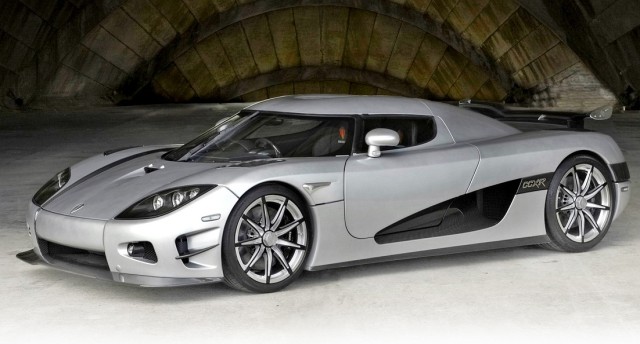 The CCXR Trevita is a limited edition of the Koenigsegg CCXR Edition featuring a diamond weave carbon fibre finish. Trevita is an abbreviation in Swedish and translates into – three whites. Up until the development of the CCXR Trevita, it has only been possible to utilize the classic black carbon fibres. The Koenigsegg Proprietary Diamond Weave, fully developed by Koenigsegg, is a new and unique method to manufacture the carbon fibre material for the CCXR Trevita. By utilising this new and unique method, Koenigsegg has managed to coat fibres with a diamond finish. The process was fully developed at Koenigsegg headquarters in Ängelholm Sweden, where the fibre treatment is conducted carefully in small quantities, prior to further processing the prepreg material. The car is 2nd world’s most expensive streetlegal supercar, it has a total price of US $4,850,000 (€3,400,000 or 35,000,000 Swedish krona).
The CCXR Trevita is a limited edition of the Koenigsegg CCXR Edition featuring a diamond weave carbon fibre finish. Trevita is an abbreviation in Swedish and translates into – three whites. Up until the development of the CCXR Trevita, it has only been possible to utilize the classic black carbon fibres. The Koenigsegg Proprietary Diamond Weave, fully developed by Koenigsegg, is a new and unique method to manufacture the carbon fibre material for the CCXR Trevita. By utilising this new and unique method, Koenigsegg has managed to coat fibres with a diamond finish. The process was fully developed at Koenigsegg headquarters in Ängelholm Sweden, where the fibre treatment is conducted carefully in small quantities, prior to further processing the prepreg material. The car is 2nd world’s most expensive streetlegal supercar, it has a total price of US $4,850,000 (€3,400,000 or 35,000,000 Swedish krona).
Only three CCXR Trevitas were produced, making one of the rarest vehicle manufactured by Koenigsegg. All three cars featured the Koenigsegg Shimmering Diamond Weave bodywork, double carbon rear wing, inconel exhaust system, carbon ceramic brakes with ABS, airbags, paddle-shift, chrono instrument cluster, infotainment system, tire monitoring system and a hydraulic lifting system.1.Maybach Exelero $8 million
 Maybach Exelero is a high-performance unique sports car, chopped-down two-seater coupe, though it’s more than just a show car – in tests at the Nardo high-speed oval, the prototype reached a speed of 218.38mph, despite weighing over 2.66 tonnes. It is capable of acceleration from 0-60mph in 4.4 seconds.
Maybach Exelero is a high-performance unique sports car, chopped-down two-seater coupe, though it’s more than just a show car – in tests at the Nardo high-speed oval, the prototype reached a speed of 218.38mph, despite weighing over 2.66 tonnes. It is capable of acceleration from 0-60mph in 4.4 seconds.The car’s design was the result of a competition amongst students at the Pforzheim Polytechnic Department of Transport Design, which has worked on show vehicles for Fulda in the past. The design of 24-year-old Fredrik Burchhardt was chosen, and his work was co-ordinated with that of the Maybach design centre in Sindelfingen. The project, based on the Maybach 57 limousine, required a certain amount of re-engineering; the A-pillar and doors had to be shifted rearwards, and the steering column, pedals and gearshift all re-located. The standard 550bhp V12 engine was bored out to 5.9 litres, and tuned for 700bhp and over 738lb ft of torque. With final dimensions of 5890mm long, 2140mm wide and just 1390mm high, the car was kitted out with a full-spec interior, including leather, neoprene, aluminium and carbonfibre finishes.
Maybach says the car, built by Stola in Turin, is “a one-off vehicle created to showcase the new ultra-high performance Exelero tyre range from leading tyre manufacturer Fulda”; it’s not the first time the two companies have teamed up, as back in 1938 Fulda demonstrated its tyres on a Maybach SW 38 limousine.
Despite its astronomical price the car is allegedly owned by Arnaud Massartic , a European entrepreneur ,while other sources claim that The Exelero has been and still is in a garage in Germany (Stuttgart area) and it is still for sale. The car is also famous for being portrayed in one of the episodes of long-running German show Cobra 11. Jay-Z featured the car in the music video for “Lost One”.















